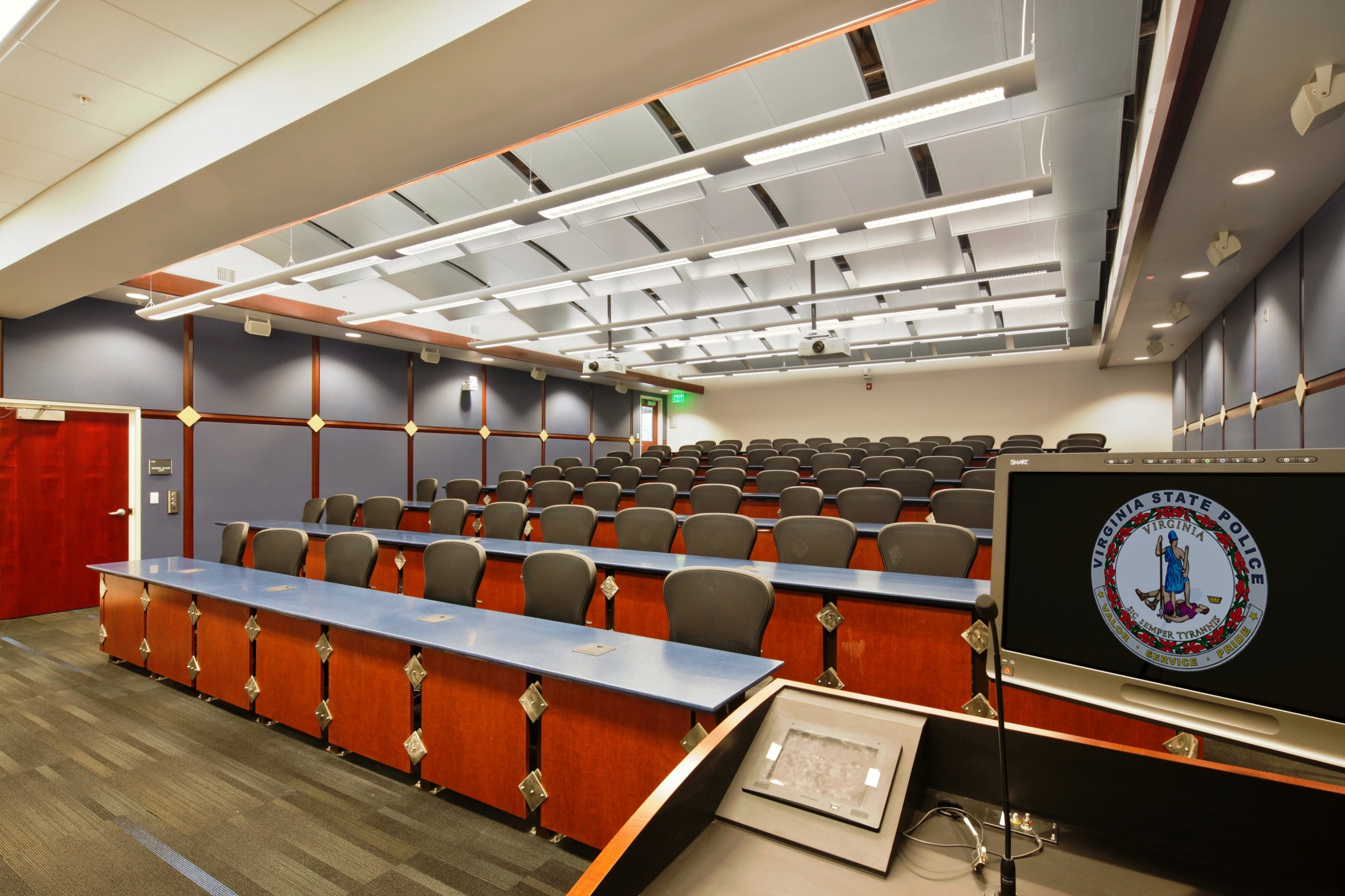The Virginia State Police will soon begin driver training in a new $27.4 million complex set on 680 acres near Fort Pickett, just outside the town of Blackstone. Designed by Dewberry and constructed by KBS Inc., the facility includes 4.5 miles of urban, rural, and interstate roadway courses that simulate Virginia topography; a three-story, 52,000-sf training and dormitory building; an observation tower; and a vehicle maintenance garage.
The new training tracks feature a variety of road configurations, including a cloverleaf ramp, city intersections, interstate acceleration lanes, a roundabout, railroad tracks, a 25,000-sf skidpan, cul-de-sacs, and a 342,000-sf precision-driving course. The facility enables the police to combine behind-the-wheel training with simulations and classroom instruction at one site.
The training building includes 60 squad rooms that accommodate up to 120 cadets, theater-style classrooms, a cafeteria, offices, meeting space, and a driver simulation room with 550 LE Interactive Driving Simulation Systems that model the cockpit of a police cruiser.
Construction of a new firing range is set to begin this spring. The building was also designed to serve as an alternate emergency operations center for the Virginia State Police.
Design of the building combines brick, precast architectural block, and glass curtainwall. “The architecture reflects the modern, state-of-the-art training approach provided by the Virginia State Police, with a streamlined academic aesthetic in the materials and vertical elements,” says Larry Hasson, AIA, who led the architectural design team for Dewberry. In addition to architecture, Dewberry provided interior design and mechanical/electrical, structural, civil, and environmental engineering. +
Related Stories
| Nov 2, 2010
A Look Back at the Navy’s First LEED Gold
Building Design+Construction takes a retrospective tour of a pace-setting LEED project.
| Oct 21, 2010
GSA confirms new LEED Gold requirement
The General Services Administration has increased its sustainability requirements and now mandates LEED Gold for its projects.
| Oct 13, 2010
Thought Leader
Sundra L. Ryce, President and CEO of SLR Contracting & Service Company, Buffalo, N.Y., talks about her firm’s success in new construction, renovation, CM, and design-build projects for the Navy, Air Force, and Buffalo Public Schools.
| Oct 13, 2010
Bookworms in Silver Spring getting new library
The residents of Silver Spring, Md., will soon have a new 112,000-sf library. The project is aiming for LEED Silver certification.
| Oct 13, 2010
County building aims for the sun, shade
The 187,032-sf East County Hall of Justice in Dublin, Calif., will be oriented to take advantage of daylighting, with exterior sunshades preventing unwanted heat gain and glare. The building is targeting LEED Silver. Strong horizontal massing helps both buildings better match their low-rise and residential neighbors.
| Oct 12, 2010
Guardian Building, Detroit, Mich.
27th Annual Reconstruction Awards—Special Recognition. The relocation and consolidation of hundreds of employees from seven departments of Wayne County, Mich., into the historic Guardian Building in downtown Detroit is a refreshing tale of smart government planning and clever financial management that will benefit taxpayers in the economically distressed region for years to come.
| Oct 12, 2010
Building 13 Naval Station, Great Lakes, Ill.
27th Annual Reconstruction Awards—Gold Award. Designed by Chicago architect Jarvis Hunt and constructed in 1903, Building 13 is one of 39 structures within the Great Lakes Historic District at Naval Station Great Lakes, Ill.
| Oct 6, 2010
Windows Keep Green Goals in View
The DOE's National Renewable Energy Laboratory has almost 600 window openings, and yet it's targeting LEED Platinum, net-zero energy use, and 50% improvement over ASHRAE 90.1. How the window ‘problem’ is part of the solution.
| Sep 21, 2010
New BOMA-Kingsley Report Shows Compression in Utilities and Total Operating Expenses
A new report from the Building Owners and Managers Association (BOMA) International and Kingsley Associates shows that property professionals are trimming building operating expenses to stay competitive in today’s challenging marketplace. The report, which analyzes data from BOMA International’s 2010 Experience Exchange Report® (EER), revealed a $0.09 (1.1 percent) decrease in total operating expenses for U.S. private-sector buildings during 2009.















